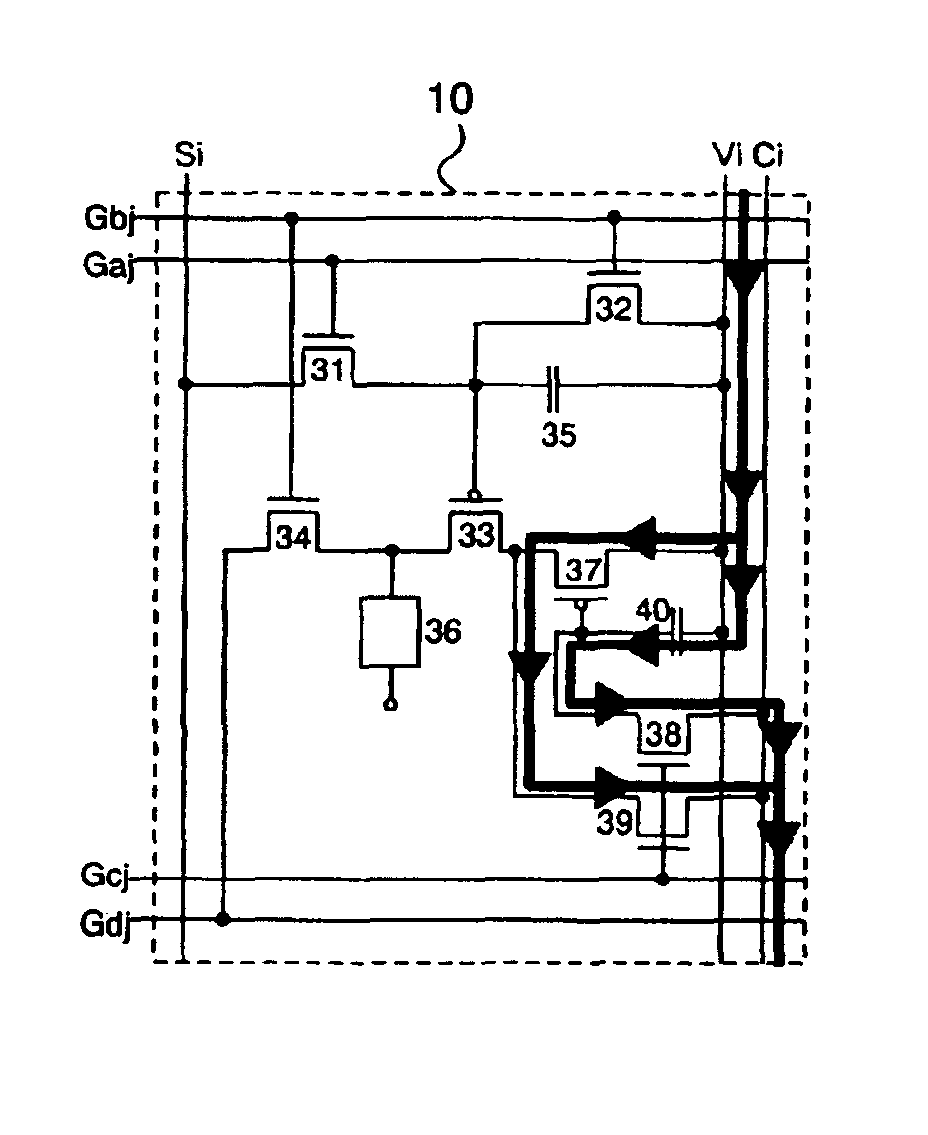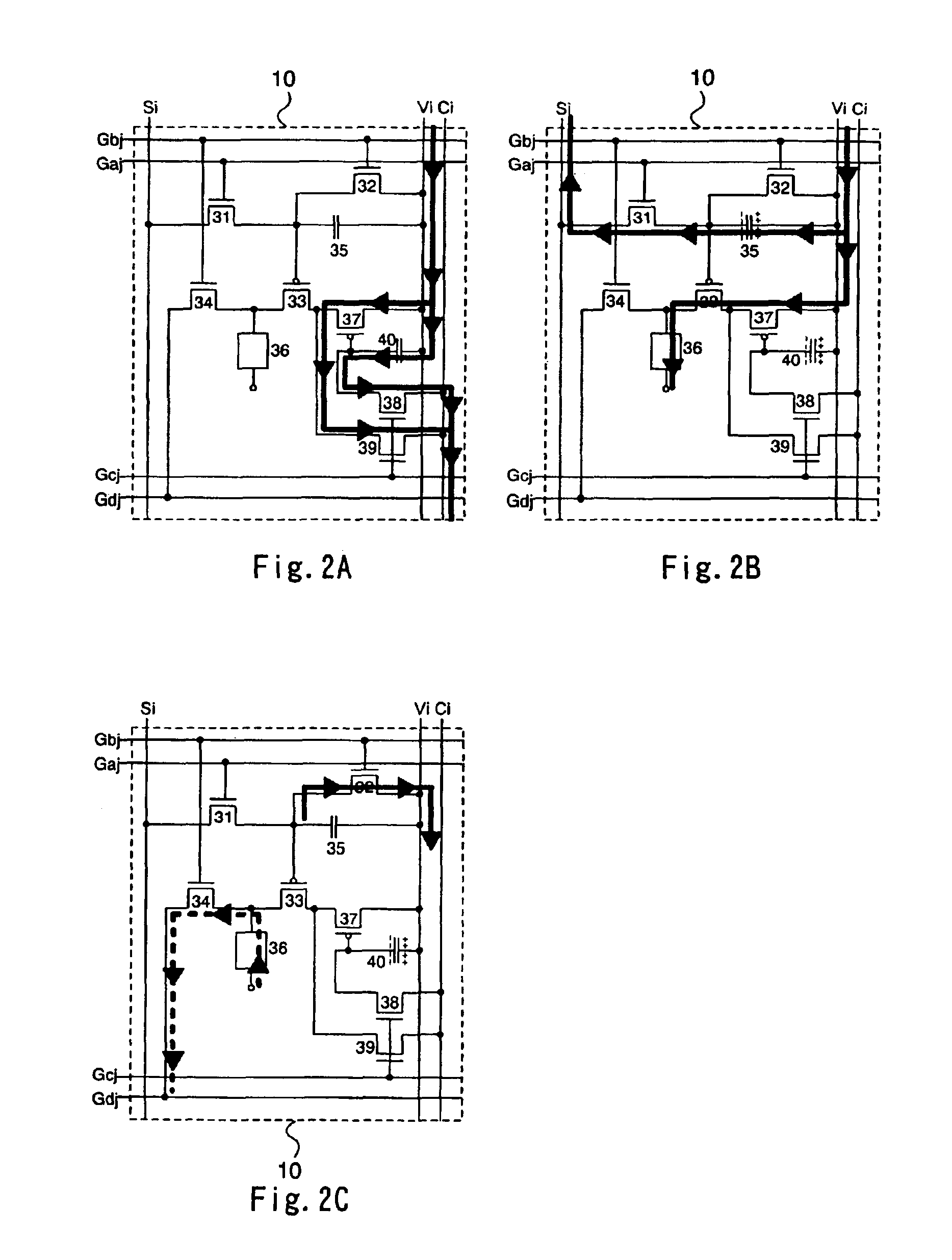Light emitting device
a light-emitting device and light-emitting technology, applied in the field of light-emitting devices, can solve the problems of low reliability, heat-resistance stability, durability, and inability to change the counter potential pixel by pixel or line, and achieve the effect of improving the accuracy of light-emitting devices and reducing the cost of light-emitting devices
- Summary
- Abstract
- Description
- Claims
- Application Information
AI Technical Summary
Benefits of technology
Problems solved by technology
Method used
Image
Examples
embodiment 1
[Embodiment 1]
[0062]Although the pixel of the light-emitting device of the present invention was outlined two kinds by using FIGS. 1A and 1B, this embodiment explains a detailed configuration example and operation of the pixel of FIG. 1A by using FIGS. 2A to 2C, 4A and 4B. Specifically, explanation is made on a case that devising is made for a connection of the gate electrode of the discharge transistor 14 configuring for the pixel 10 shown in FIG. 1A, by using FIGS. 2A to 2C, 4A and 4B. Furthermore, explanation is made on a layout of the pixel 10 shown in FIGS. 2A to 2C, by using FIGS. 3A and 3B.
[0063]In FIG. 2A, the pixel 10 includes a select transistor 31, an erase transistor 32, a drive transistor 33, a discharge transistor 34, a capacitance element 35, a light-emitting element 36, a current-source transistor 37, a set transistor 38, a set transistor 39 and a capacitance element 40. Also, the pixel 10 has a first scanning line (Gaj)—a fourth scanning line (Gdj), a signal line (S...
embodiment 2
[Embodiment 2]
[0087]Embodiment 1 explained the case that devising is made for the connection of the gate electrode of the discharge transistor 14 of FIG. 1A. This embodiment explains a case that devising is made for a connection of the source electrode of the discharge transistor 14 of FIG. 1A using FIGS. 5A to 5D.
[0088]The pixel 10 shown in FIG. 2A and the pixel 10 shown in FIGS. 5A to 5D are the same in the number of the elements configuring the pixel 10 and the connection relationship between the elements excepting the difference in connection of the discharge transistor 34 (hereinafter, denoted as a transistor 34), and hence detailed explanation is omitted in this embodiment.
[0089]In FIGS. 5A to 5D, the transistor 34 has a gate electrode connected to the fourth scanning line (Gdj). In the pixel 10 shown in FIG. 5A, the transistor 34 has a source electrode connected to the first scanning line (Gaj) while, in the pixel 10 shown in FIG. 5B, the transistor 34 has a source electrode ...
embodiment 3
[Embodiment 3]
[0095]Although two kinds or more of the pixel outline of the light-emitting device of the invention was mentioned using by FIGS. 1A and 1B, this embodiment explains a detailed configuration example and operation of the pixel of FIG. 1B by using FIGS. 6A to 6C. Note that FIGS. 6A to 6C show, as a discharge diode 24, a transistor in diode connection.
[0096]The pixel 10 shown in FIG. 2A and the pixel 10 shown in FIGS. 6A to 6C are the same in the number of the elements configuring the pixel 10 and the connection relationship between the elements except the difference in connection of the discharge transistor 34 (hereinafter, denoted as a transistor 34), and hence the details on the connection of elements are omitted in this embodiment.
[0097]In the pixel 10 shown in FIG. 6A, the transistor 34 is an n-channel type. The transistor 34 has a gate electrode and a drain electrode that are connected with each other. Also, the transistor 34 has a source electrode connected to the f...
PUM
 Login to View More
Login to View More Abstract
Description
Claims
Application Information
 Login to View More
Login to View More - R&D
- Intellectual Property
- Life Sciences
- Materials
- Tech Scout
- Unparalleled Data Quality
- Higher Quality Content
- 60% Fewer Hallucinations
Browse by: Latest US Patents, China's latest patents, Technical Efficacy Thesaurus, Application Domain, Technology Topic, Popular Technical Reports.
© 2025 PatSnap. All rights reserved.Legal|Privacy policy|Modern Slavery Act Transparency Statement|Sitemap|About US| Contact US: help@patsnap.com



